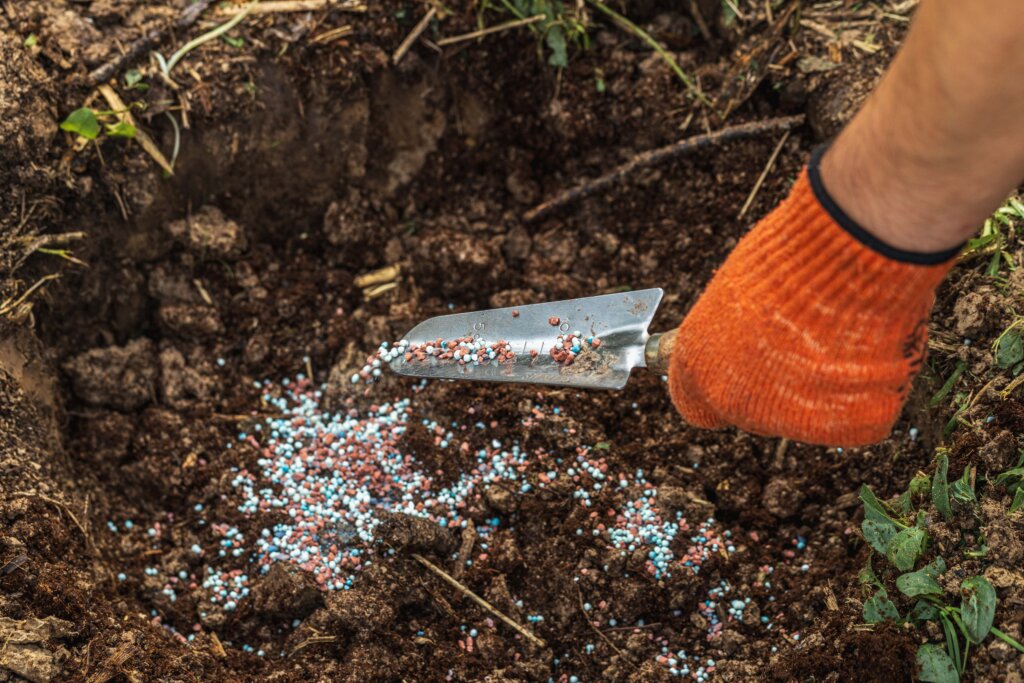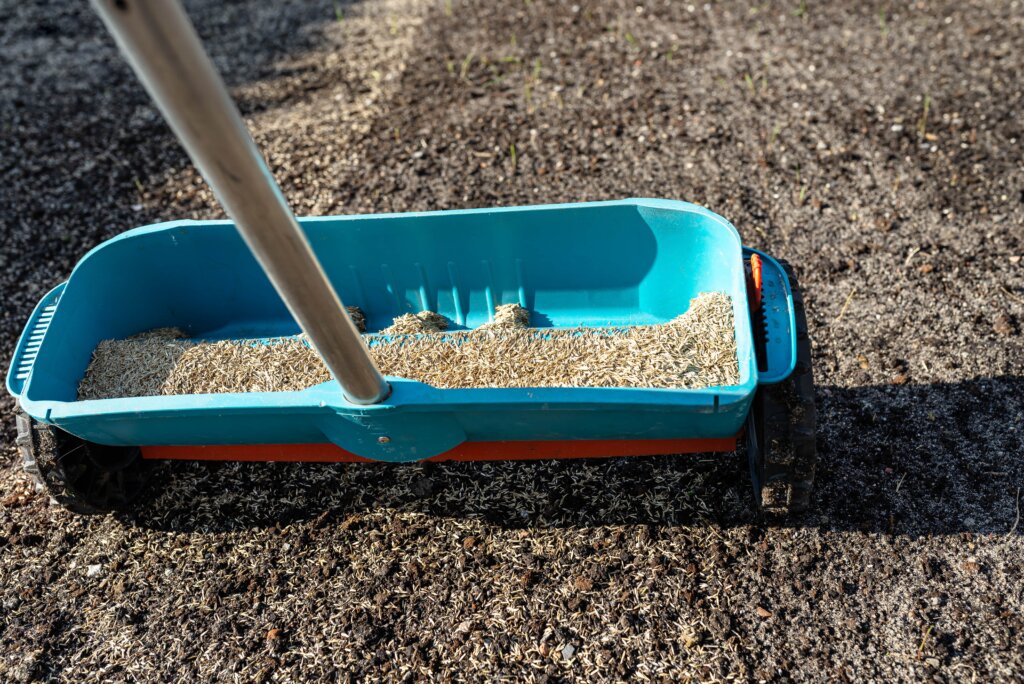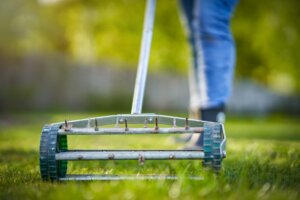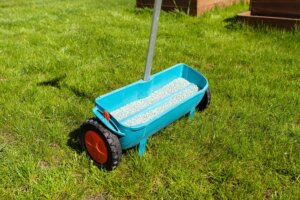Starting a new lawn? The right lawn starter fertilizer can make all the difference, helping your grass seed or sod take root faster and grow greener from day one.
Key Takeaways
- Apply lawn starter fertilizer when seeding or laying sod to help roots grow strong.
- Choose a phosphorus-rich formula; it’s key for early root development.
- Start with a soil test to find out what nutrients your new lawn needs.
- Water after applying, then switch to regular lawn fertilizer after 6–8 weeks for lasting growth.
What Is Lawn Starter Fertilizer?
A lawn starter fertilizer is a nutrient mix designed to support new grass seed, sod, or turf during the earliest stages of growth. Unlike regular lawn fertilizer, a starter formula emphasizes phosphorus (P), the nutrient responsible for strong root development and early grass establishment.

As noted by the University of California Agriculture and Natural Resources, starter fertilizers feature a high middle number in their N-P-K ratio (Nitrogen-Phosphorus-Potassium), often appearing as 10-20-10 or 18-24-12, to ensure your new lawn has the essential nutrients it needs to thrive from day one.
Why Starter Fertilizer Matters for New Lawns
When you’re seeding, laying new sod, or repairing bare spots, starter fertilizer helps your grass roots establish quickly. Here’s how the primary nutrients contribute:
| Nutrient | Function | Why It Matters |
|---|---|---|
| Nitrogen (N) | Promotes lush green growth | Supports early leaf development |
| Phosphorus (P) | Encourages root growth | Essential for new seed and sod establishment |
| Potassium (K) | Builds stress tolerance | Strengthens turf against drought and disease |
A starter fertilizer is especially beneficial in Pennsylvania’s variable seasons, from cool spring seeding to fall overseeding, where deep roots help lawns survive winter dormancy and summer drought.
When to Put Starter Fertilizer on Grass

Apply starter fertilizer when you plant new grass seed or lay sod, not before. Timing is key to maximizing absorption and minimizing nutrient runoff.
Best results come from these steps:
1. Soil Test First:
Determine what your soil test shows before adding nutrients.
2. Apply During Seeding or Sodding:
Mix the fertilizer into the top 2–3 inches of soil before planting.
3. Water Immediately:
Light watering helps nutrients reach the developing roots.
If you’re unsure when to apply or what your soil needs, check out our full guide: When to Apply Starter Fertilizer.
How to Apply Starter Fertilizer Correctly
Applying the proper fertilizer ensures your new grass seed or sod gets nutrients without overloading the soil.
Step-by-Step Application Process
1. Measure Your Lawn:
Calculate the area in sq ft to determine how much fertilizer you need.
2. Use the Recommended Rate:
Typically, 0.5–1 lb. of nitrogen per 1,000 sq. ft. is ideal.
3. Evenly Spread the Fertilizer:
Use a broadcast or drop spreader for uniform coverage.
4. Water Thoroughly:
Helps activate the fertilizer and promotes germination.
For visual learners, our guide on How to Apply Lawn Fertilizer explains the process in detail.
Choosing a Great Starter Fertilizer
Not all lawn fertilizer options are the same. Pick one that fits your grass type and soil test results for the best new lawn growth.
| Lawn Type | Recommended Fertilizer & Benefits |
|---|---|
| Cool-Season Lawns (e.g., Kentucky Bluegrass, Tall Fescue) | Use a higher phosphorus blend to boost early root growth. Ideal for spring or fall planting. |
| Warm-Season Lawns (e.g., Bermuda, Zoysia) | Choose a balanced NPK ratio for steady nutrient release and stronger drought resistance. Best for summer growth. |
If your soil already has enough phosphate, switch to a phosphorus-free mix to stay eco-friendly and compliant with Pennsylvania lawn care guidelines. For homeowners within our Service Area, we provide tailored programs for seeding, aeration, and fertilization designed for Pennsylvania soil and weather conditions.
How Long Does Starter Fertilizer Last?
Most granular starter fertilizers are slow-release, feeding your new turf for up to 6–8 weeks. After that, switch to a regular fertilizer to support continued growth. Learn how to make that transition smoothly in our guide: How to Fertilize Lawn.
Post-Fertilization Care: Watering, Mowing, and Maintenance

After applying starter fertilizer:
- Water lightly but regularly: Keep the soil moist to promote seed germination.
- Avoid Mowing Too Early: Wait until the grass reaches 3–4 inches before cutting.
- Feed Again After 6–8 Weeks: Use a balanced lawn fertilizer to maintain color and thickness.
If you’re curious about timing, our post on Should You Water Your Lawn After Fertilizing? offers science-backed watering tips.
Common Mistakes to Avoid
Even the best starter fertilizer can harm your new lawn if misused. Avoid these pitfalls:
- Skipping the Soil Test: Applying fertilizer blindly can cause nutrient imbalance.
- Using Too High a Dose: Excess nitrogen can burn new seedlings.
- Applying on Wet Soil: Leads to runoff and wasted nutrients.
When used correctly, your lawn will establish faster, greener, and healthier, especially during the crucial first weeks of development.
Do You Really Need Starter Fertilizer?

Yes, especially if you’re planting new seed, laying sod, or repairing thin patches. Starter fertilizer gives young grass a nutrient head start before switching to regular fertilizer. Established lawns, however, may not need it unless you’re overseeding or working with bare spots.
Supporting Pennsylvania Lawns the Right Way
As a locally owned and family-operated company since 2003, Terra Lawn Care has helped homeowners across the Tri-State area (PA, NJ, DE) build healthier, greener lawns. With over 50 years of combined agronomy experience, our state-certified lawn technicians know what your soil and your grass need to thrive.
If you’re ready to take the next step toward a lush, vibrant lawn, learn more about our professional Lawn Fertilization Services.
The Bottom Line
Using the right lawn starter fertilizer sets the foundation for a healthy, durable lawn. Begin with a soil test, apply at seeding or sodding, and follow up with proper watering and mowing.
For personalized lawn care advice or professional fertilization programs in Pennsylvania, connect with our experts at Terra Lawn Care. Your new lawn deserves the best start, and with the right fertilizer and expert guidance, it can become the greenest yard on the block.
Frequently Asked Questions About Lawn Starter Fertilizer
A good grass starter fertilizer has more phosphorus to boost early root and grass development in new lawns or freshly laid sod. Look for a granular formula with an NPK ratio like 10-20-10 or 18-24-12—these give your lawn the good stuff it needs for growth.
For tall fescue or Kentucky bluegrass, phosphorus supports strong roots, while iron keeps the turf a rich green. Apply about 1 lb. of nitrogen per 1,000 sq ft, following the rate on the bag to protect your lawn’s health.
Yes, but it depends on your soil test results. Starter fertilizers are made for lawn seed and new sod, so applying them to existing grass with enough phosphorus won’t add much benefit.
For an established lawn, switch to a balanced fertilizer higher in nitrogen and potassium (or potash) to maintain color, density, and health. Use it evenly across your site to support steady growth without overstimulating the roots.
Wait about 6–8 weeks before applying regular lawn fertilizer. This gives the micro nutrients from the starter time to fully support root growth before adding more nitrogen and potassium.
After this period, a standard feeding program helps your grass development continue through the next growth phase, improving the turf’s resilience and overall health.
Using too much can cause more harm than good. Over-applying granular fertilizer can burn young roots and lead to nutrient runoff that affects nearby landscaping.
Too much nitrogen or potash may also weaken your turf instead of strengthening it. Always measure your sq ft area carefully and follow the directions on the bag. If you’re unsure, ask a professional for a review of your fertilizer rate to protect your lawn’s long-term health.



